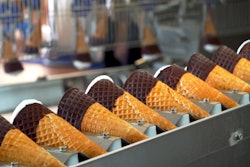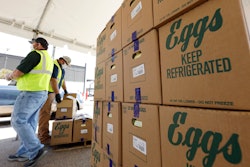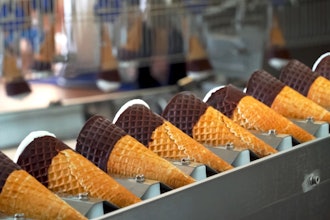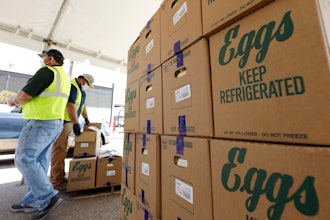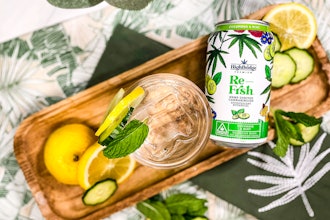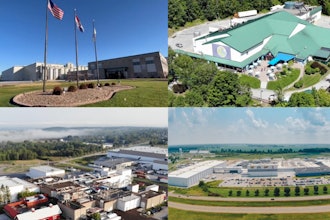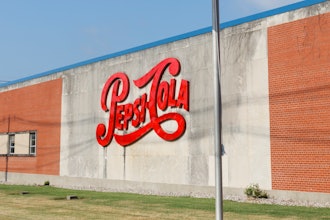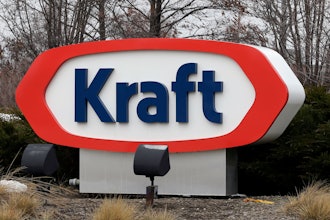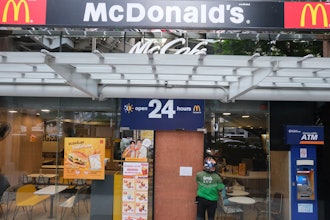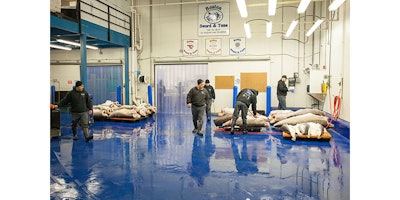
Floors in cold stores and refrigerated areas need to be able to withstand extreme temperatures for long periods of time. Should they fail, cracks or gaps could appear in the surface and pose a dangerous contamination risk.
Specifying flooring that is up to the task means making sure the coating can withstand a variety of challenges for an extended period of time. One of the main factors that the floor needs to be prepared for is the consistently low temperature; however point loading, impacts, foot traffic and chemical exposure all need to be factored in as well.
Many food and beverage producers opt for a ¼”-3/8” thick cementitious urethane coating in refrigerated areas in order to ensure a long-lasting finish. Cementitious urethane systems are available that combine cement and water-based polyurethane technologies to create a robust finish that will retain a functional surface despite prolonged exposure to temperatures as low as -49°F.
This type of flooring is also highly effective at surviving thermal shock and temperatures at the opposite extreme as high as 250°F, which means that the floor won’t fail if the cold store is cleaned using hot water or steam.
Many simple aspects of the working day could also lead to an impact or wear-related floor failure within a food production plant’s refrigerated area. For example the interior could contain machinery and well-stocked containers, or the staff may be carrying (and potentially dropping) heavy tools and product.
 Flowcrete Americas
Flowcrete AmericasAll of these factors could chip away at the floor finish. If the floor coating is a thin system, then this initial impact could expose the substrate. Water and food byproducts could then get into this chip and undermine the coating.
A thick cementitious urethane coating helps to avoid this problem, as not only will it have a better chance of dissipating the impact but also should a chip occur, then it would not progress down to the substrate. The floor’s impact resistance requirement should be tailored to the environment — the more chance and severity of impact, the thicker the floor coating should be to protect the critical bond layer where the coating meets the concrete.
As well as thermal shock, thermal cycling can adversely affect the floor finish. This occurs when the temperature is gradually raised and lowered, so if a cold room’s ambient temperature changes over time then it could result in a failed floor finish.
Cementitious urethane systems have a thermal coefficient of expansion similar to that of concrete, meaning that when the floor is exposed to thermal cycling the finish will expand and contract in line with the concrete substrate underneath. Flooring materials that fail to move with the substrate will crack along the surface, creating unsightly and unhygienic gaps where contaminants can accumulate.
Many of these cold storage flooring issues were encountered recently at Boston Sword & Tuna’s seafood processing plant. The company’s facility required a new finish that would provide a reliable and hygienic surface for an extended period of time despite a variety of operational challenges such as a constantly low temperature, frequent and continuous exposure to freezing cold water and ice, movement of wheeled equipment, heavy pallets full of freshly caught tuna, foot traffic and regular cleaning.
Previously Boston Sword & Tuna had experienced problems with floors that had cracked, as water would then get underneath it and ruin the coating. To prevent this from happening again, 10,000 square feet of an antimicrobial enhanced, cementitious urethane floor was installed. This solution would make sure that the finish underfoot would reliably support the site’s daily workload while providing an easy to clean surface that would help to keep the site clean and hygienic with the minimum of hassle.
The new floor was also designed to create a textured finish that would enhance traction underfoot and minimize the risk of dangerous slips or trips. This was a particular priority for Boston Sword & Tuna’s processing facility, as water, ice and fish byproducts would inevitably spill onto the floor. The seamless, impervious nature of the floor, combined with high coving and stainless steel drainage incorporated into the finish, meant that any contaminants and excess liquid could be quickly and easily washed out of the area to reduce potential slip and contamination risks.
The cleanability properties of Boston Sword & Tuna’s new floor would ensure that the site complied with the stringent regulations governing building materials in the food industry. In this regard, it is particularly important to specify floors that comply with Hazard Analysis and Critical Control Points (HACCP) principles throughout a food processing facility — including in any cold or refrigerated areas.
HACCP provides an advisory framework for each aspect of the design and construction of a food and beverage plant. Its guidelines have become largely ubiquitous in the food and beverage industry, with Food Safety Management Systems based on HACCP principles now a legal requirement under the FDA and USDA for all juice, seafood, meat and poultry processing plants in the US.
Getting the floor area right is critical to this, as the HACCP guidelines highlight the importance of seamless and impervious flooring. This is because seams, joints, grout lines and gaps can become breeding sites for bacteria, fungi, mold and mildew. In contrast, making sure that the floor provides a seamless surface will help the cleaning regime quickly wash any unwanted substances out of the area.
It is important to ensure that the floor is able to maintain these properties for an extended period of time, as otherwise its seamlessness or imperviousness could be compromised and degraded by the site’s workload, turning a previously HACCP standard finish into an unsightly, unsanitary and unsafe surface.
 Flowcrete Americas
Flowcrete AmericasAnother key consideration for flooring in refrigerated areas is that they can be particularly tricky to refurbish, as many operators will not want to bring the area up to an ambient temperature to apply a new floor.
Resin systems are available that have been enhanced with the inclusion of a methyl methacrylate (MMA) additive, which rapidly speeds up the floor’s rate of cure and also means that they can be effectively installed at lower temperatures than alternative resin solutions. Using an MMA system avoids the time and effort that would otherwise be needed to raise the ambient temperature in the refrigerated area high enough in order to refurbish it using most alternative flooring materials.
The fact that an MMA floor significantly cuts down on the length of time required to install the floor is a great practical asset for food and beverage businesses undertaking a refurbishment, as it means that they can shorten the period of unprofitable downtime and get the site up and running at full capacity again sooner than would otherwise have been possible.
One issue to bear in mind when specifying MMA floors is that they have a unique odor that, while harmless, most food producers will want to keep away from the produce. This can be easily achieved by removing any on-site foodstuffs from the immediate area during the application, ensuring that there is adequate ventilation during installation and allowing an appropriate amount of time to allow the odor to dissipate.
When choosing a floor for a refrigerated area it is important to analyze the demands that the coating will have to withstand and then carefully discuss these with the supplier and applicator to ensure that the system under consideration will provide all the properties required to create a high performance and long lasting finish.





